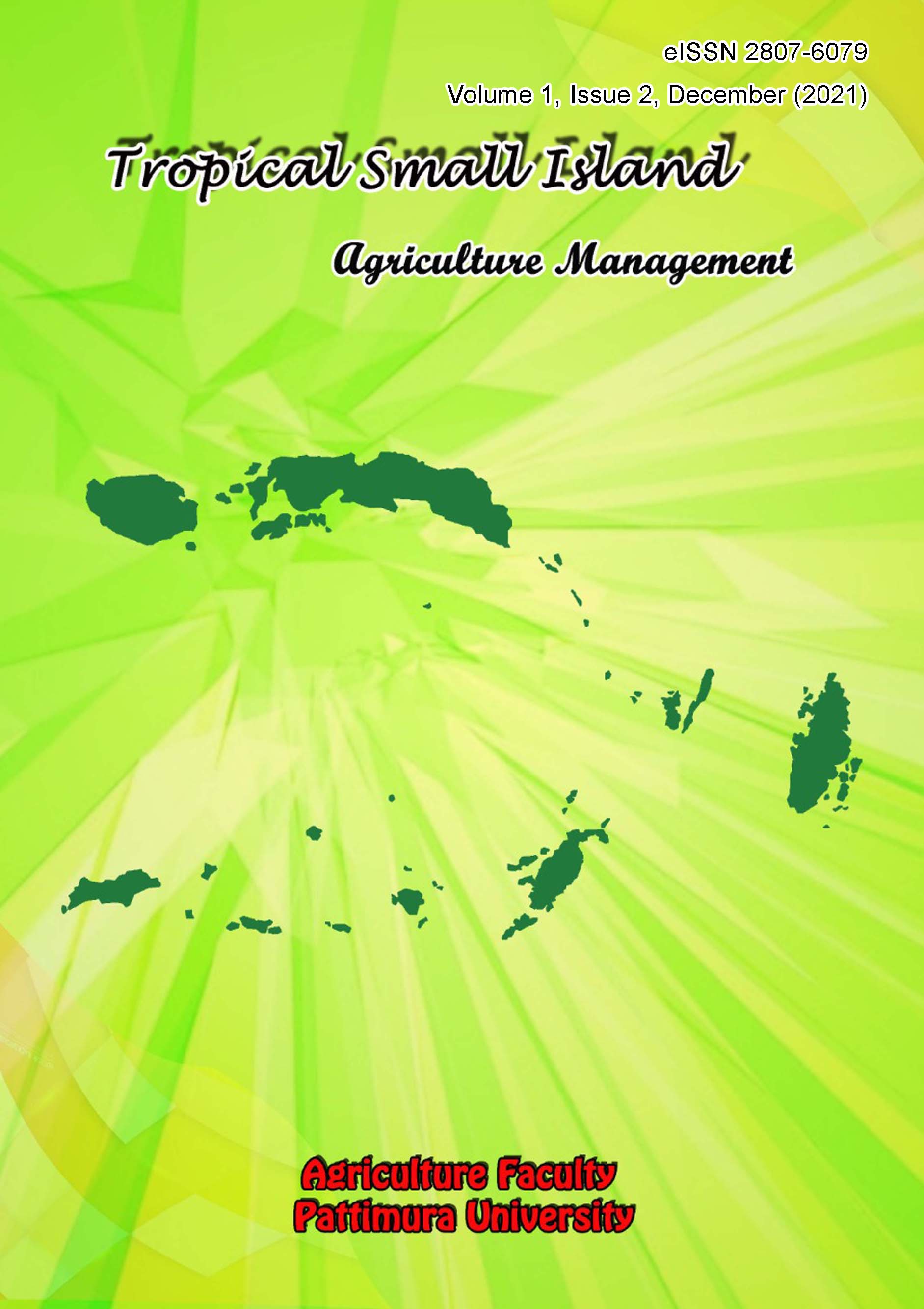The establishment of twelve island groups as a development directive in Maluku Province
Abstract
This research was created to test the existence of the determination of twelve groups of development islands that are by the development of development in the field of forestry. Biophysical, social and economic data were used to test the twelve island clusters' determination. Cluster analysis is used in testing the determination of twelve island clusters. The kaiser-Meyer-Elkin (KME) and multicollinearity tests are used to obtain data quality in cluster analysis. The cluster analysis results using twelve variables free of multicollinearity (VIF) resulted in five island clusters. Cluster analysis using Ward's method with Kophenitic distance (Cophenetic Distance) provides maximum results, where the distance between the furthest groups (between classes) of 76028208246067.70 or 97.15% and the closest distance of fellow groups 2228914432702.33 or 2.85 %.Downloads
References
Azhar, S. C., Aris, A. Z., Yusoff, M. K., Ramli, M. F., & Juahir, H. (2015). Classification of River Water Quality Using Multivariate Analysis. Procedia Environmental Sciences. https://doi.org/10.1016/j.proenv.2015.10.014
Badan Pusat Statistik Provinsi Maluku (BPS). (2019). Indeks Pembangunan Manusia (IPM) menurut Kabupaten / Kota di Provinsi Maluku tahun 2018. https://maluku.bps.go.id/statictable/2019/05/07/324/indeks-pembangunan-manusia-ipm-menurut-kabupaten-kota-di-provinsi-maluku-2017-2018.html
Beller, W., D’Ayala, P., & Hein, P. (1990). Overview: Sustainable development and environmental management of small islands. Sustainable Development and Environmental Management of Small Islands. Serie: Man and the Biosphere, 5, 3–13.
Ghozali, I. (2018). Aplikasi Analisis Multivariate dengan Program IBM SPSS 25 Edisi 9. Badan Penerbit Universitas Diponegoro.
Hajigholizadeh, M., & Melesse, A. M. (2017). Assortment and spatiotemporal analysis of surface water quality using cluster and discriminant analyses. Catena. https://doi.org/10.1016/j.catena.2016.12.018
Hidayah, Z., Rosyid, D. M., & Armono, H. D. (2016). Planning for Sustainable Small Island Management: Case Study of Gili Timur Island East Java Province Indonesia. Procedia - Social and Behavioral Sciences, 227(November 2015), 785–790. https://doi.org/10.1016/j.sbspro.2016.06.146
IBM. (2019). KMO and Bartlett’s Test. IBM Knowledge Center.
Johnson, R. A., & Winchern, D. W. (2007). Applied Multivariate Statistics. Pearson Education Inc.
Legendre, P., & Legendre, L. (2012). Cluster analysis. In Developments in Environmental Modelling. https://doi.org/10.1016/B978-0-444-53868-0.50008-3
Papilaya, P., Suhendang, E., Jaya, I. N. S., & Rusolono, T. (2021). Quantitative approach for reclassification of the spatial cluster of archipelagos in Maluku Province for the basis of forest development. Telkomnika (Telecommunication Computing Electronics and Control), 19(5). https://doi.org/10.12928/TELKOMNIKA.v19i5.17041
Pérez-Vicente, S., & Expósito Ruiz, M. (2009). Descriptive statistics. Allergologia et Immunopathologia. https://doi.org/10.1016/j.aller.2009.10.005
Polido, A., João, E., & Ramos, T. B. (2014). Sustainability approaches and strategic environmental assessment in small islands: An integrative review. In Ocean and Coastal Management. https://doi.org/10.1016/j.ocecoaman.2014.05.005
Rockwell, R. C. (1975). Assessment of Multicollinearity: The Haitovsky Test of the Determinant. Sociological Methods & Research. https://doi.org/10.1177/004912417500300304
Shrestha, S., & Kazama, F. (2007). Assessment of surface water quality using multivariate statistical techniques: A case study of the Fuji river basin, Japan. Environmental Modelling and Software. https://doi.org/10.1016/j.envsoft.2006.02.001
Singh, K. P., Malik, A., Mohan, D., & Sinha, S. (2004). Multivariate statistical techniques for the evaluation of spatial and temporal variations in water quality of Gomti River (India) - A case study. Water Research. https://doi.org/10.1016/j.watres.2004.06.011
Copyright (c) 2022 Patrich P E Papilaya, I N S Jaya, Tri Rusolono

This work is licensed under a Creative Commons Attribution-ShareAlike 4.0 International License.
Authors who publish with this journal agree to the following terms:
- Authors retain copyright and grant the journal right of first publication with the work simultaneously licensed under a Creative Commons Attribution License that allows others to share the work with an acknowledgment of the work's authorship and initial publication in this journal.
- Authors are able to enter into separate, additional contractual arrangements for the non-exclusive distribution of the journal's published version of the work (e.g., post it to an institutional repository or publish it in a book), with an acknowledgment of its initial publication in this journal.
- Authors are permitted and encouraged to post their work online (e.g., in institutional repositories or on their website) prior to and during the submission process, as it can lead to productive exchanges, as well as earlier and greater citation of published work (See The Effect of Open Access).









